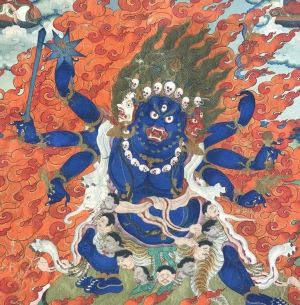Chöd Puja: Celebrating the Essence of Enlightened Female Wisdom
29 January 2014 – Tergar Monastery, Bodhgaya
In an historic occasion coming at the end of the first Arya Kshema Winter Dharma Gathering, nuns from six Kagyu nunneries performed an elaborate Chöd ritual, known as A String of Jewels, presided over by the 17th Gyalwang Karmapa.
While the Gyalwang Karmapa has been enthusiastic about Chöd practice from a young age, this was his first ever opportunity to publicly perform the Chöd puja—an opportunity he’d been looking forward to very much.
Since the time of the 3rd Karmapa, Rangjung Dorje, who wrote the first commentary on Chöd and who also compiled the text of this puja, the Karmapas have had a strong connection with the Chöd practice. Historically they are holders of the direct Chöd lineage, based on the Indian Buddhist deity Prajñāpāramitā, who is known as both the mother of all the Buddhas and the embodiment of wisdom.
Chöd, which means ‘to sever or cut’ in Tibetan, ultimately aims to cut through the ignorance of self-grasping that is the root of all our suffering, using the wisdom that realizes emptiness. It is renowned among the eight practice lineages of Tibetan Buddhism as being the only lineage established by a woman, the great female master Machig Labdrön, and female practitioners have traditionally excelled in its practice.
From the first opening strains the nuns’ melodies rang clear and bell-like throughout the gompa, the soaring notes of the puja carried effortlessly by the female voices.
The gompa was transformed for the puja, with rows of nuns seated on raised cushions facing inwards in the traditional arrangement, while a row of Geshes, Khenpos and venerable monks were seated to either side of the Gyalwang Karmapa’s throne. The nuns skillfully performed all the traditional roles of the puja, including Umze or chantmaster, Chöpon or ritual-master, as well as playing all the horns, drums, and other ritual implements.
Those present witnessed the spectacular sight of rows of nuns playing their ritual chöd-dar drums and bells in unison, led by the Gyalwang Karmapa at the head of the gathering. At points in the puja the haunting sound of kangling horns, famously made from thigh-bones, reverberated through the air, in a direct symbol of cutting through gross attachment to the physical body.
Arising from the enlightened female wisdom principle, the power of the morning’s Chöd practice was magnified under the unified voices of hundreds of nuns. Throughout the five-hour-long ritual, the Gyalwang Karmapa presided as Dorje Lopon or vajra master, his powerful, supportive presence guiding the nuns through to the end of the puja.
